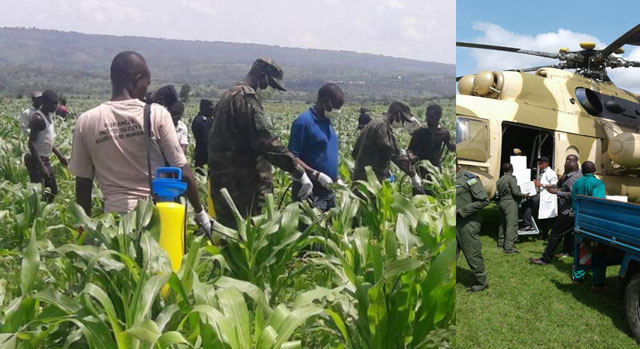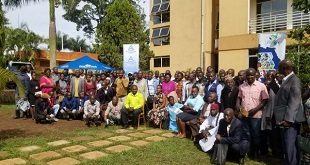
Multi-pronged approach key for effectively defeating fall armyworm in Africa
NAIROBI, Kenya – Tackling the menace of the tenacious fall armyworm pest and avoiding economic hardship for smallholders across Africa requires multi-institutional collaboration, scientists attending a continental stakeholders consultation meeting on the fall armyworm, have said.
In their meeting in the past week in Nairobi, the scientists said the fight against the pest requires quick and coordinated action, a massive awareness campaign and scientific innovation.
The fall armyworm, a recent interloper in Africa widely prevalent in the Americas attacks more than 80 different plant species, including maize, a major food staple in sub-Saharan Africa on which more than 200 million people depend.
“The truly frightening risk of the fall armyworm to food security in Africa must be recognized and tackled with a holistic integrated pest management program,” said B.M. Prasanna, director of the Global Maize Program at the International Maize and Wheat Improvement Center (CIMMYT) and the CGIAR Research Program on Maize.
A conservative estimate indicates the loss of Africa’s maize due to the fall armyworm could cost the continent $3 billion in the coming year, according to Roger Day, sanitary and phytosanitary coordinator at the Center for Agricultural and Biosciences International(CABI).
The fall armyworm has been reported in all countries in southern Africa except Lesotho plus most countries in eastern Africa, including Kenya, Tanzania, Uganda, Rwanda, Ethiopia and Burundi. It has also been reported in several countries in West and Central Africa, including Nigeria, Ghana, Benin, Togo, Democratic Republic of Congo and the island nation of Sao Tome Principe.
“We cannot eliminate the pest from Africa – now that it is here, it will stay, but we can provide support to farmers and provide options to manage their crops against the fall armyworm,” B.M. Prasanna told the meeting.
The female fall armyworm can lay up to 1,000 eggs at a time and can produce multiple generations very quickly without pause in tropical environments.
“We just don’t know how far this could go,” said Joe DeVries, vice president, program development and innovation at the Alliance for a Green Revolution in Africa (AGRA).
“Fall Armyworm is a very recently-introduced pest in Africa and even the experts are unsure what its long-term impact will be. We agreed on the urgency of enabling national plant protection groups to work with farmers in controlling the level of damage on their farms. Longer-term, though, only a truly collaborative effort between international and national agencies can provide a solution.”
Multi-pronged approach key for effectively defeating fall armyworm in Africa https://t.co/3TUAdCGFRE #FallArmyworm #maize #corn pic.twitter.com/8maZnAfKGC
— Julie Mollins (@jmollins) April 30, 2017
Integrated management
“The first step to an effective integrated pest management strategy is to survey and monitor pest movements, yield loss levels and to compile data using remote sensing equipment and at the field level,” said Gabriel Rugalema, the Food and Agriculture Organization (FAO) country representative for Kenya. “Accumulated data can contribute to establishing uniform cross-continent government standards for identifying and fighting the pest.”
“We need to act fast, failure is not an option,” Rugalema said, adding that adequate funding and taking a regional approach to controlling the fall armyworm are vital.
Future challenge
Scientists believe that the fall armyworm may have spread and proliferated on the continent due to warmer global temperatures over the past few years. They suspect the pests may have travelled from the Americas in warm ocean jet streams or arrived by some other form of transportation.
Scientists fear the fall armyworm could continue to multiply and become endemic across the continent. Professor Kenneth Wilson at Britain’s Lancaster University, who has extensive experience working on the African Armyworm, predicts the pest could potentially spread into the Middle East and eventually to Europe.
The moth has been known to fly distances of up to 1,600 kilometers (1,000 miles) in 30 hours, according to experts.
Scientists noted that Brazil, a tropical country that has also battled the FAW could be a useful benchmark for understanding how to manage the pest in Africa, which typically does not have the natural control measure of freezing temperatures.
“We need to develop and deploy in a fast-track manner improved drought tolerant, disease resistant hybrids adapted to Africa that are also resistant to the fall armyworm,” Prasanna said. “This is possible in the medium-term of five to six years, while other effective integrated pest management options are scaled-up and delivered to the farming communities.”
Some ideas for building resilience and combatting the fall armyworm:
-
Combination of cultural, biological and biopesticide control
-
Develop host plant resistance (conventional and transgenic)
-
Low-cost chemicals, protective clothing, spraying equipment
-
Heat, drought, pest resistant hybrid crops
-
Heat, drought, pest resistant genetically modified crops
-
Identification of predatory insects
-
Pheromone traps to lure moths to target and destroy eggs and larvae
-
Use of biopesticides for natural distribution by birds or other animals
-
Tool allowing laborers to pluck pests out of plants
Build resilience
Despite the challenges, we are continuing to build resilience, increase agricultural productivity and regional coordination on agriculture, said Candace Buzzard, deputy mission director at the U.S. Agency for International Development (USAID) in Kenya and East Africa.
“Resilience is the ability of communities, countries and systems to respond to shocks,” she said, hopefully by building more resilience within all these systems, which includes early warning, which includes the farmer level by building resilience we can reduce the effects of these shocks and be more prepared for them.”
 The Independent Uganda: You get the Truth we Pay the Price
The Independent Uganda: You get the Truth we Pay the Price



